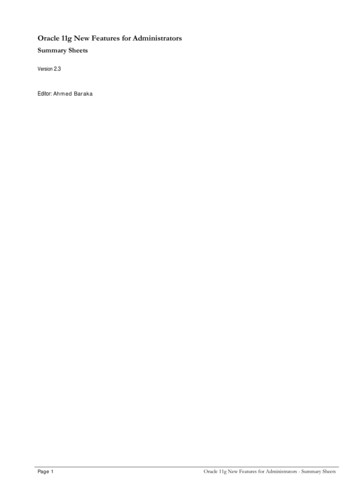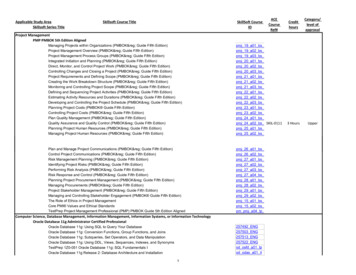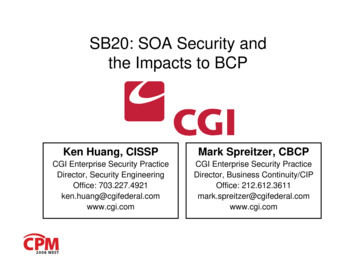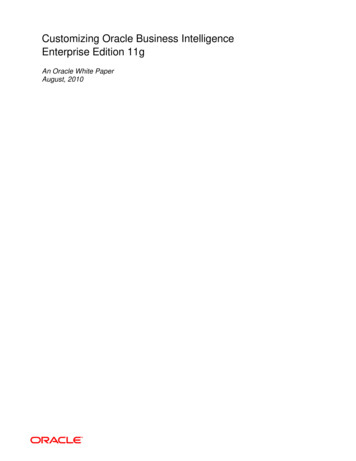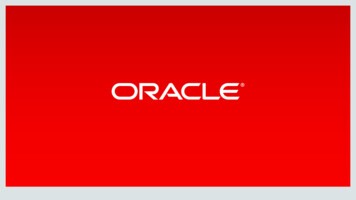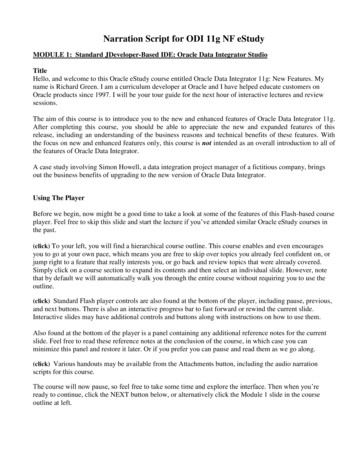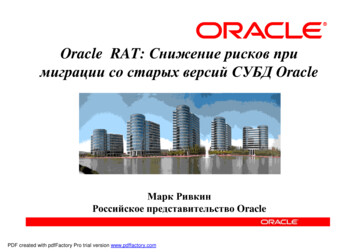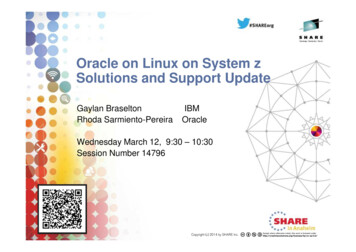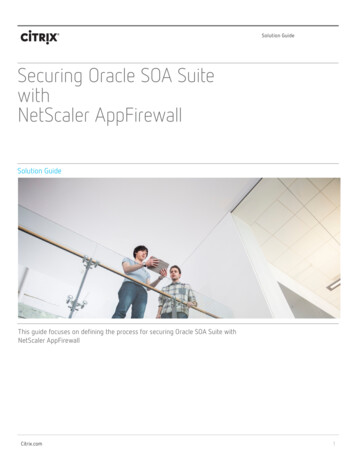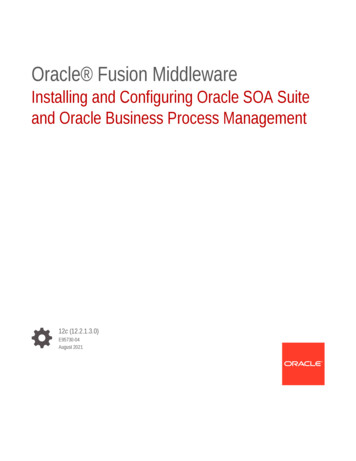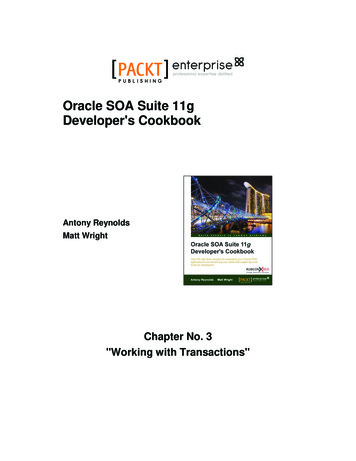
Transcription
Oracle SOA Suite 11gDeveloper's CookbookAntony ReynoldsMatt WrightChapter No. 3"Working with Transactions"
In this package, you will find:A Biography of the authors of the bookA preview chapter from the book, Chapter NO.3 "Working with Transactions"A synopsis of the book’s contentInformation on where to buy this bookAbout the AuthorsAntony Reynolds has worked in the IT industry for more than 25 years, first getting ajob to maintain yield calculations for a zinc smelter while still an undergraduate. Aftergraduating from the University of Bristol with a degree in Mathematics and ComputerScience, he worked first for a software house, IPL in Bath, England, before joining thetravel reservations system Galileo as a development team lead. Galileo gave him theopportunity to work in Colorado and Illinois where he developed a love for the Rockiesand Chicago style deep pan pizza.Since joining Oracle in 1998, he has worked in sales consulting and support. He currentlyworks as a Sales Consultant helping customers across North America realize the benefitsof standards based integration and SOA. While at Oracle he has co-authored Oracle SOASuite Developer's Guide, Packt Publishing and Oracle SOA Suite 11g R1 Developer'sGuide, Packt Publishing.Antony lives in Colorado with his wife and four children who make sure that he isgainfully employed playing games, watching movies, and acting as an auxiliary taxiservice. He is a slow but steady runner and can often be seen jogging up and down thetrails in the shadow of the Rocky Mountains.For More ed-architecture-suite-11gdevelopers-cookbook/book
I would like to thank my wife Rowan, and my four very patient children,who have put up with my staying at home on family trips and working latenights in my basement office as I completed this book. My managers Ed Leeand Troy Hewitt were very supportive and many of my colleaguescontributed knowingly or unknowingly to the recipes.I am appreciative of Michael Weingartner and his team for their continuedenhancement and development of the SOA Suite which has enabled Mattand myself to write this book. The reviewers provided valuable guidanceand corrections and any errors still remaining are entirely mine. Finally, theteam at Packt Publishing constantly nagged and cajoled Matt and myself tokeep some sort of schedule. Without them this book would still be on thedrawing board.Matt Wright is a director at Rubicon Red, an independent consulting firm helpingcustomers enable enterprise agility and operational excellence through the adoptionof technologies such as Service-Oriented Architecture (SOA), Business ProcessManagement (BPM), and Cloud Computing.With over 20 years of experience in building enterprise scale distributed systems, Mattfirst became involved with SOA shortly after the initial submission of SOAP 1.1 to theW3C in 2000, and has worked with some of the early adopters of BPEL since its initialrelease in 2002. Since then, he has been engaged in some of the earliest SOA-basedimplementations across EMEA and APAC.Prior to Rubicon Red, he held various senior roles within Oracle, most recently asDirector of Product Management for Oracle Fusion Middleware in APAC, where hewas responsible for working with organizations to educate and enable them in realizingthe full business benefits of SOA in solving complex business problems.As a recognized authority on SOA, he is a regular speaker and instructor at privateand public events. He also enjoys writing and publishes his own blog(http://blogs.bpel-people. com). He holds a B.Sc. (Eng) in Computer Sciencefrom Imperial College, University of London.He has worked on Oracle SOA Suite Developer's Guide, Packt Publishing and OracleSOA Suite 11g R1 Developer's Guide, Packt Publishing.For More ed-architecture-suite-11gdevelopers-cookbook/book
I would like to express my deep appreciation to everyone who has reviewedthis book. Their invaluable feedback and advice not only helped to validatethe overall accuracy of the content, but more importantly ensure its clarityand readability.A book like this doesn't make it into print without a lot of work from thepublisher. I would like to thank the team at Packt Publishing for all theirsupport; especially Stephanie Moss, Leena Purkait, and Susmita Panda.A special mention must go to John Deeb for his continual encouragement,input, and above all support in ensuring that I found time to write the book;I couldn't ask for a more supportive friend and business partner.Finally, I would like to say a very, very special thank you to my wife Natashaand my children Elliot and Kimberley, who have been incredibly patient andsupportive in allowing me to spend far too many evenings and weekendsstuck away in my office writing this book.For More ed-architecture-suite-11gdevelopers-cookbook/book
Oracle SOA Suite 11gDeveloper's CookbookService Oriented Architecture (SOA) provides the architectural framework neededto integrate diverse systems together and create new composite applications. Oracle SOASuite 11gR1 provides the tools needed to turn an SOA architecture into a workingsolution. SOA Suite provides the developer with several high level components such as: Oracle Service Bus (OSB), an enterprise strength service bus for full support ofservice bus patterns including validation, enrichment, transformation, and routing(the VETRO pattern) Service Component Architecture (SCA) that hosts a number of components Business Activity Monitoring (BAM) that provides real-time reporting on SOASuite activitiesSCA components include: Mediator for light weight transformation and routing Rules for abstraction of business rules BPEL for orchestrating long running or complex integrations Human workflow (HWF) for allowing human interaction with long runningprocesses Spring for integrating Java Spring componentsThis book looks at many common problems that are encountered when integratingsystems and provides solutions to them in the form of more than 67 cookbook recipes.The solutions explain the problem to be solved alongside clear step by step instructionsto implement a solution using SOA Suite components. Each recipe also includesa discussion of how it works and what additional problems may be tackled by thesolution presented.For More ed-architecture-suite-11gdevelopers-cookbook/book
What This Book CoversChapter 1, Building an SOA Suite Cluster, explains how to prepare the environmentto follow Oracle's Enterprise Deployment Guide. The Enterprise Deployment Guideis Oracle's blueprint for building a highly available SOA Suite cluster. The chapterincludes key questions to ask the network storage team, the networking team, and theDatabase Administrators before the actual SOA Suite installation and deployment begins.Chapter 2, Using the Metadata Service to Share XML Artifacts, explains how we canuse MDS to share XML artifacts, such as XML schemas, WSDL's fault policies, XSLTTransformations, EDLs for event EDN event definitions and Schematrons betweenmultiple composites.Chapter 3, Working with Transactions, looks at the different ways to use transactionswithin SOA Suite. This includes enrolling a BPEL process in an existing transaction,forcibly committing or aborting a transaction within BPEL and catching faults thathave caused the transaction to be rolled back. It also covers how to apply reversingtransactions when a system does not support transaction functionality in itspublic interface.Chapter 4, Mapping Data, covers how to copy and transform data using the SCAcontainer. It includes how to deal with missing XML elements and how to controlthe mapping of Java objects to XML including dealing with abstract Java classes.It also covers how to process arrays of data in both BPEL and XML stylesheettransforms (XSLT).Chapter 5, Composite Messaging Patterns, explores some of the more complex butrelatively common message interaction patterns used in a typical SOA deployment.It includes recipes for implementing patterns around message aggregation, singletons,and the dynamic scheduling of BPEL processes and services.Chapter 6, OSB Messaging Patterns, explores some common message processingdesign patterns for delegation of execution to downstream services and provides recipesfor implementing them using Oracle Service Bus. It includes recipes for dynamic bindingto services, splitting out messages, as well as dynamic Split-Joins.Chapter 7, Integrating OSB with JSON, covers how we can use the Service Bus tointegrate with RESTful web services that exchange data using JavaScript Object Notation(JSON) instead of XML. It also looks at how to expose OSB Services as RESTful JSONweb services.Chapter 8, Compressed File Adapter Patterns, explains how to use the file/FTP adapterto compress/uncompress the contents of exchanged files. This is particularly commonin Business-to-Business scenarios, where network bandwidth is more of a constraint.For More ed-architecture-suite-11gdevelopers-cookbook/book
Chapter 9, Integrating Java with SOA Suite, explains different ways to integrate Javacode into SOA Suite. This is demonstrated through creating a custom XPath functionfor use in SCA and OSB, as well as re-using EJBs and Spring Beans in SOA Suite. Italso shows how to access the SOA runtime environment from within a BPEL process.Chapter 10, Securing Composites and Calling Secure Web Services, shows the developerhow to restrict access to a composite by applying a security policy, as well as showinghow to create a new security policy. It also explains how to make a call to a securityprotected service and how to manage security stores.Chapter 11, Configuring the Identity Service, details how to configure the OraclePlatform Security Services (OPSS) to use various LDAP providers for authenticationand authorization within the Oracle SOA Suite. It covers configuration for ActiveDirectory, Oracle Internet Directory, Sun iPlanet, and Oracle Virtual Directory.Chapter 12, Configuring OSB to use Foreign JMS Queues, covers how to configure theService Bus to read/write messages from various JMS providers, including OC4J, JBoss,and across WebLogic domains.Chapter 13, Monitoring and Management, includes recipes to monitor the completionstatus of SOA composites through the EM dashboard, measuring their messagethroughput in real time. It also covers setting up the SOA environment to use the SOASuite provided Monitor Express reports to take advantage of pre-built BAM dashboards.For More ed-architecture-suite-11gdevelopers-cookbook/book
3Working withTransactionsIn this chapter we will cover:fModifying a BPEL process to use the callers transaction contextfCommitting a transactionfAborting transactionfCatching rollback faultsfApplying a reversing or compensating transactionIntroductionIn this chapter we will examine recipes that allow us to control the transactional behaviorof composites.Transactions definedA transaction may be thought of as a set of changes to the state of a system. All the changesmust be applied together or none of the changes must be applied. For example, a transferbetween two bank accounts involves two operations, debiting the payer's account andcrediting the payee's account. In this case, if the credit operation fails we don't want todebit the payer's account because the money was not deposited in the payee's account.For More ed-architecture-suite-11gdevelopers-cookbook/book
Working with TransactionsWe may have more than two changes in a transaction. For example, in addition to transferringthe funds in our example, which requires two operations, we may also wish to notify the payerand payee that the transfer has occurred. Again, we want this to be part of the transactionbecause we do not want to send a notification unless the transfer of funds has also occurred,so we have now extended our transaction to four operations.Transaction managersA transaction manager is responsible for coordinating the operations in a transaction. If allthe operations are in the same resource, such as the same database, then the resource maymanage the transaction itself. If the transaction is spread across multiple resources, such asthe database and message queue, then an XA transaction manager is required to co-ordinatethe operations across different resources.SOA Suite by default will use the XA transaction manager in the application server to coordinate its transactions. When a message arrives in SOA Suite, an XA transaction is started.Compensating transactionsNot all transactions are managed by a transaction manager. Sometimes we want thebenefits of a transaction but the services we are using are non-transactional, for examplebasic SOAP over HTTP services. In this case, we need to manage the transactional behaviorwithin our composites.In our example, if the two accounts are held at two separate banking institutions, thingscould become more complicated. This does not change the transaction requirements; it justmakes implementing a transaction more complicated. We must now provide explicit reversingtransactions to undo unwanted work when we are unable to complete all the operations in ourtransaction. These are called compensating transactions.Within SOA Suite, the BPEL engine has built-in support for compensating transactions thatallow us to register and invoke reversing operations (compensating transactions).Hints on working with SOA Suite transactionsAlways have a clear plan of where you want transactionboundaries to occur. Determine if you want BPEL processesto be part of existing transactions or if you want to executethem within their own transaction. Transactions can becommitted by using a dehydrate statement or by calling anon-idempotent service. It is often helpful to create a diagramshowing transaction boundaries within your composite.50For More ed-architecture-suite-11gdevelopers-cookbook/book
Chapter 3Modifying a BPEL process to use the callerstransaction contextWe often want to include a BPEL process in the calling transaction, and this recipe shows howto modify the BPEL process to do this.Getting readyIn JDeveloper, open the project that has the BPEL process that we want to make part of thecalling transaction.How to do it.1. Switch to Source View.In JDevelper, open composite.xml that contains the BPEL process and click on theSource tab at the bottom of the diagram:2. Add a Transaction Required property.Find the component that corresponds to the BPEL process in Source View; thecomponent name attribute will be the same as the name of the BPEL process. Adda property called bpel.config.transaction with the value required to thecomponent, as shown in the following code: component name "TransactionIDProcess" version "1.1" implementation.bpel src "TransactionIDProcess.bpel"/ property name "bpel.config.transaction"many "false"type "xs:string" required /property /component The BPEL process will now participate in the same transaction as the caller of the process.51For More ed-architecture-suite-11gdevelopers-cookbook/book
Working with TransactionsHow it works.When creating a BPEL process with sync delivery in SOA Suite 11.1.1.6 and higher, we canspecify the transaction attributes of the BPEL process as required or requiresNew. Thissets the bpel.config.transaction property.The bpel.config.transaction property has two values:frequired: This makes the BPEL process execute as part of the calling transaction.If no calling transaction exists, it will create a new one.frequiresNew: This is the default value and makes the BPEL process execute as aseparate transaction. Any existing transaction will be suspended.These properties define the transaction semantics of the BPEL process to which they areapplied. Any JCA adapters, such as a database or JMS adapter, can also be executed in thesame transaction context as the BPEL process.There's more.When executing, the BPEL engine keeps track of which activities have occurred by updatingthe state in the dehydration database. This updating of the process state is done in thesame transaction context in which the BPEL process is being executed. This keeps thestate of the BPEL process in sync with the state of the resources used by the BPEL process.These updates are only committed when the process is dehydrated or a RequiresNewprocess is completed. One way in which this can occur is following a call to a non-idempotentpartner link.The BPEL engine uses a separate transaction context to keep a record of which steps wereattempted; this is used to update the database with logging information and means thateven if the BPEL process transaction rolls back, it will be possible to see what activities wereexecuted before the rollback. This aids in debugging a failing BPEL process.See alsofThe Aborting a transaction recipe in this chapter.Committing a transactionWe may wish to explicitly commit a transaction in our BPEL process. This recipe describes howto achieve this.52For More ed-architecture-suite-11gdevelopers-cookbook/book
Chapter 3Getting readyIn JDeveloper, open the project containing the BPEL process that you wish to explicitly commita transaction to.How to do it.1. Add a Dehydrate activity to the process.2. Open the BPEL process that needs to explicitly commit the transaction.3. From the Component Palette expand the Oracle Extensions section; drag aDehydrate activity onto the BPEL process:When executed, this will cause the current transaction to be committed and a new transactionto be started.53For More ed-architecture-suite-11gdevelopers-cookbook/book
Working with TransactionsHow it works.The Dehydrate activity causes the current state of the BPEL process to be saved in thedehydration database. This also causes the current transaction context to be committed.Because the BPEL process is still active, a new transaction context is immediately created.There's more.A Dehydrate activity can be very useful in an asynchronous process, but should be avoided ina synchronous process unless the BPEL process's bpel.config.transaction property isnot set or set to requiresNew.Synchronous BPEL processes that have the requiredtransaction attribute should always leave the committingof the transaction to the caller; they should never forcethe committing of a transaction.See alsofThe Catching rollback faults recipe in this chapter.Aborting a transactionIf an error occurs while we are in a transaction, we may wish to abort the transaction, thusrolling back any work that has already been done. This recipe shows how to rollback thecurrently executing transaction.Getting readyIn JDeveloper, open the project containing the BPEL process, which may encounter errors,requiring the transaction to be rolled back.How to do it.1. Open the BPEL process that needs to cause the transaction to be rolled back.54For More ed-architecture-suite-11gdevelopers-cookbook/book
Chapter 32. From the Component Palette, drag a Throw activity onto the BPEL process:3. Double-click on the Throw activity that was created in the previous step.4. Click on the icon in the Fault QName section of the dialog to launch theFault Chooser dialog:55For More ed-architecture-suite-11gdevelopers-cookbook/book
Working with Transactions5. Select the rollback fault and click on OK:6. Click on OK to apply the changes to the Throw activity.This activity will cause the current BPEL process transaction to be rolled back when executed.How it works.The rollback fault has a special meaning to the BPEL engine and causes the currenttransaction to be rolled back. The BPEL process will be restored to the state that it was inbefore the current transaction was started. A rollback fault can't be caught by a BPELprocess in the same transaction context.See alsofThe Catching rollback faults recipe in this chapterCatching rollback faultsA BPEL process may want to catch a rollback fault thrown by another BPEL process. Thisrecipe shows how to do that.Getting readyOpen the composites containing the caller BPEL process and the callee BPEL process.56For More ed-architecture-suite-11gdevelopers-cookbook/book
Chapter 3How to do it.1. Open composite.xml containing the callee BPEL process (the BPEL process thatthrows a rollback fault) and switch to the Source View tab.2. Locate the component element corresponding to the callee BPEL process and verifythat either:There is no bpel.config.transaction property: component name "BPELProcess1" version "1.1" implementation.bpel src "BPELProcess1.bpel"/ !—No bpel.config.transaction property -- /component Or the bpel.config.transaction property is set to requiresNew: component name "BPELProcess2" version "1.1" implementation.bpel src "BPELProcess2.bpel"/ property name "bpel.config.transaction"many "false"type "xs:string" requiresNew /property /component 3. Open the caller BPEL process and add a catch block by selecting the triangular ( )icon on a scope containing the invoke activity to the callee BPEL process:4. Double click on the Catch to bring up the Catch dialog.57For More ed-architecture-suite-11gdevelopers-cookbook/book
Working with Transactions5. Click on the icon in the Fault Name section of the dialog to launch the FaultChooser dialog:6. Select the remoteFault fault and click on OK:7.Click on OK to apply the changes to the catch.58For More ed-architecture-suite-11gdevelopers-cookbook/book
Chapter 3How it works.The catch block is to be executed when a rollback fault is thrown in the calleeBPEL process.When a BPEL process throws a rollback fault, it cannot be caught in the currenttransaction context. When the fault leaves the current transaction context, it is converted toa remoteFault that can be caught in the caller BPEL process. It is necessary to make surethat the caller and callee are in separate transaction contexts; hence the need to check thevalue of the bpel.config.transaction property is not set to required.When a BPEL process throws any fault that is not caught in the current transaction context,it causes the current transaction to be rolled back. If instead of throwing a fault a BPELprocess returns a fault through a reply activity, then the current transaction is notrolled back.Applying reversing or compensatingtransactionsIf operations occur that are not part of a transaction, then reversing operations must beapplied to undo the changes. The reversing operations are performed to reverse the effectsof the unwanted operations. This recipe shows how to do that.Getting readyOpen the BPEL process that performs operations that cannot be rolled back as part ofa transaction, and instead requires reversing operations to be applied in the case of aprocessing failure.59For More ed-architecture-suite-11gdevelopers-cookbook/book
Working with TransactionsHow to do it.1. For each operation (usually an invoke activity) that has a corresponding reversingoperation, wrap it in a scope activity by dragging a scope from the ComponentPalette and dropping it just after the operation that requires reversing:2. Move the activity or activities that require reversing into the scope bydragging-and-dropping them into the scope:60For More ed-architecture-suite-11gdevelopers-cookbook/book
Chapter 33. Click on the Add Compensation Handler iconcompensation handler:in the scope to add a4. Drag appropriate activities (usually an assign and an invoke) into thecompensation handler to reverse the operations in the corresponding scope:61For More ed-architecture-suite-11gdevelopers-cookbook/book
Working with Transactions5. If a failure in an operation does not throw a fault, then create a Throw activity bydragging it into the scope that contains the failed operation (see step 2 of the recipeAborting a transaction in this chapter).6. Choose an appropriate fault type (see step 4 of the recipe Aborting a transaction).7.Drag appropriate activities (usually an assign and an invoke) into thecompensation handler to reverse the operations in the corresponding scope.8. Add a catch block to the outermost scope (see step 3 of the recipe Catchingrollback faults).9. Drag a Compensate activity from the Component Palette onto the catch thatwas just created:62For More ed-architecture-suite-11gdevelopers-cookbook/book
Chapter 3How it works.When a fault is caught by catch, compensate it will cause all the operations that requirereversing to be reversed.Compensate can only be called from within a catch block. When it is called, it starts withthe most recently completed scope and calls the compensation handler for that scopeif it has one. It then looks for the previously completed scope and calls the compensationhandler for that scope. In this way, the reversing operations are applied in the reverse orderto the original operations. If a scope was not completed, its compensation handler will notbe invoked.If an operation throws a fault, we can catch it and call the Compensate activity. Operationsmay indicate failure by returning a failure status rather than throwing a fault. In this case,by placing a Throw activity inside the scope for which the operation failed, we can avoid thereversing operation being invoked for that scope.Compensation occurs outside of transaction boundaries. So a BPEL process may bespread across several transactions, but compensation ignores this and continues to invokecompensation handlers for completed scopes regardless of the transaction context in whichthey were completed.63For More ed-architecture-suite-11gdevelopers-cookbook/book
Where to buy this bookYou can buy Oracle SOA Suite 11g Developer's Cookbook from the Packt Publishingwebsite: hitecture-suite-11g-developers-cookbook/book.Free shipping to the US, UK, Europe and selected Asian countries. For more information, pleaseread our shipping policy.Alternatively, you can buy the book from Amazon, BN.com, Computer Manuals andmost internet book retailers.www.PacktPub.comFor More ed-architecture-suite-11gdevelopers-cookbook/book
Oracle Service Bus (OSB), an enterprise strength service bus for full support of service bus patterns including validation, enrichment, transformation, and routing . Chapter 9, Integrating Java with SOA Suite, explains different ways to integrate Java code into SOA Suite. This is demonstrated through cr eating a custom XPath function
